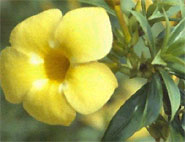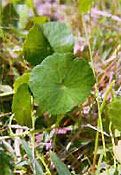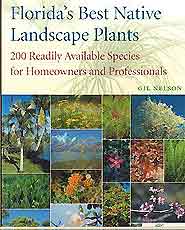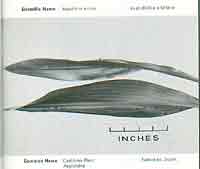Sunday, May 30, 2004
Allamande left and do-se-do
 I was cleaning up the front garden this morning - very early to avoid getting baked in the hot sun. I have a gorgeous bougainvillea that loves its spot and gets a bit overexuberant. Consequently, it tries to cover everything else around it - the periwinkles, daylilies, and my green peppers (yep, my veggies are mixed in with the flowers). Right next to the bougainvillea, or so I thought, was a jasmine vine. It has a bad habit of sprouting up everywhere in this particular garden. I've gotten rid of some of it and some I've contained by cutting them into small bushes, or so it lets me think.
I was cleaning up the front garden this morning - very early to avoid getting baked in the hot sun. I have a gorgeous bougainvillea that loves its spot and gets a bit overexuberant. Consequently, it tries to cover everything else around it - the periwinkles, daylilies, and my green peppers (yep, my veggies are mixed in with the flowers). Right next to the bougainvillea, or so I thought, was a jasmine vine. It has a bad habit of sprouting up everywhere in this particular garden. I've gotten rid of some of it and some I've contained by cutting them into small bushes, or so it lets me think.
Anyway, it was time to trim the bougainvillea and definitely cut back the jasmine. Imagine my surprise when I found an allamanda bush smack dab between the two. It apparently has been pretty happy to just be there, but obviously was not getting enough sun to bloom those fabulous yellow flowers. So, now what to do. Do I get rid of the jasmine, move the bougainvillea, or relocate the allamanda bush?
The bougainvillea was a birthday gift from my husband when we first moved into this house. Since my birthday is around Christmas, the poor thing got a bit neglected and was not planted until it started gasping for a permanent home. I planted it, fully expecting it was going to die particularly since it had dropped all of its leaves. It took a little bit of time, but that baby started getting new leaves and before long it was large enough that I actually had to start cutting it back. So, the bougainvillea was definitely not moving. The jasmine, while annoying with its greedy little space grabbing habit, fills an otherwise kind of empty spot. And fills it very nicely without trying to take over the stair rail, so it wasn't moving either. That left one choice. Move the allamanda, but where?
I looked over all the beds in the front and side yard and couldn't find a place where it would flourish better than this particular garden. This bed is perfect for heavier bloomers since it gets morning and early afternoon sun until about 4PM. So, I had to be creative and come up with a solution. Then it finally dawned on me. Allamande left! Just like the square dance. Alright, so it's spelled differently (allemande)- the principle is the same. The jasmine got trimmed a little heavier to make room for its neighbor and I'll try to encourage it to grow in the other direction if I can. (Of course I'm not holding my breath on that one.) And the allamanda got a roomer new home in the sun to the left of the jasmine where it can bloom to its heart's content. I'm looking forward to seeing it flower and will share a picture when it does. In the meantime, take a tip from me and practice your square dance steps with your plants. Happy Florida Gardening.
Saturday, May 29, 2004
Beautiful butterflies
 I learned in reading the St. Pete Times today that the Miami blue butterfly may be experiencing a comeback. University of Florida scientists have released caterpillars in Everglades and Biscayne national parks. The caterpillars came from eggs from one of the last colonies found in 1999 at Bahia Honda State Park. If the project is successful, the caterpillars will become butterflies within the next couple of weeks.
I learned in reading the St. Pete Times today that the Miami blue butterfly may be experiencing a comeback. University of Florida scientists have released caterpillars in Everglades and Biscayne national parks. The caterpillars came from eggs from one of the last colonies found in 1999 at Bahia Honda State Park. If the project is successful, the caterpillars will become butterflies within the next couple of weeks.
Don't you just love butterflies? They are such magnificant creatures in a tremendous variety of colors and sizes. Pinellas County holds butterfly counts twice a year, spring and fall. Numbers of volunteers gather to count and record as many butterflies as they can. There's even a website, The Northern Prairie Wildlife Research Center that contains checklists for counties throughout the US who have recorded butterfly sightings.
So, reading about the blue butterfly and thinking about the butterfly counts got me wondering about butterflies. Like how do they survive and how long they live. I found a site called the Butterflies Starting Page that provides just that kind of info. For instance, did you know that butterflies can only fly if their body temperature is above 86 degrees? Or, did you know that some butterflies can fly at speeds of 30 mph or faster? Questions are answered and photos provided at this interesting site.
Just so you know, there are 6 families and 17 recorded subfamilies of butterflies in Pinellas County and counting. We'll see what the fall brings. Happy Florida Gardening.
Thursday, May 27, 2004
Scourge of the Florida earth -- dollar weed!
 I never heard of dollar weed before I moved here, but I'll tell you what. After 9 years, I can identify dollar weed at 100 paces. This weed is the most tenacious plant I have ever encountered and I've rustled with a few. Up north it was crab grass and we did everything we could to eradicate it. Down here, we call it St. Augustine grass and we try to grow it. Go figure.
I never heard of dollar weed before I moved here, but I'll tell you what. After 9 years, I can identify dollar weed at 100 paces. This weed is the most tenacious plant I have ever encountered and I've rustled with a few. Up north it was crab grass and we did everything we could to eradicate it. Down here, we call it St. Augustine grass and we try to grow it. Go figure.
So, back to dollar weed. Our backyard was actually fairly weed free when we moved here. Then we had some soil delivered so we could prevent any flooding from the pond and the first little seedlings began to pop their ugly little heads. It has now spread throughout the entire backyard, particularly in the area I was hoping to landscape.
Dollar weed, for the novices reading this, grows in wet areas and can be partially controlled by reducing the amount of water it receives. That, my friend, is a bunch of hooey. I don't care how wet or dry it is, dollar weed aka pennywort grows anywhere it wants anytime it wants. The plant spreads through underground runners and try as you might, you can never pull the entire runner out of the ground. There will always be a little piece there just waiting to sprout. It's sorta like the plant in Little Shop of Horrors - it will never go away.
Chemicals will help to control it but I don't like chemical use, especially around the pond and our pets. So, I have finally decided to stop fighting it. In fact, I'm going to let it become my ground cover and plant around and through it. This way my landscaping will look green and luscious, if no one looks closely, and I won't have to get down on my hands and knees to keep pulling it out! Happy Florida Gardening.
Friday, May 21, 2004
I'm a raving maniac!
 And it's all because of Florida's Best Native Landscape Plants by Gil Nelson. I know I mentioned this book in a previous article, but I just can't get over what I'm learning about Florida native plants.
And it's all because of Florida's Best Native Landscape Plants by Gil Nelson. I know I mentioned this book in a previous article, but I just can't get over what I'm learning about Florida native plants.
I purchased this book for a number of reasons. We wanted to start planting native plants so we could stop pampering the plants that don't work as well here. Properly placed, native plants don't need the same amount of water and they tolerate the sandy soil much better than other species. We don't have to be concerned with cold hardiness since native plants thrive in our climate. Finally, once established these plants will bloom and grow with minimum care.
I'm learning something new every time I pick up this reference book. For instance, did you know that Stokes' aster is native to Florida? I sure didn't. How about the Black-eyed susan or Lobelia or Liatris or St. John's Wort? Wow. What a wealth of information all in one place. I've looked through my book at least ten times since I got it from BOOKSAMILLION.COM
Tuesday, May 18, 2004
You say aspidistra, I say cast-iron plant
 So, we're finally sitting on the front porch after working our behinds into a garage-cleaning frenzy. We're sipping on libations, and my husband asks, "What's that plant behind the canary palm?" I had to admit I hadn't a clue! It's been growing there very nicely since before we moved in, and I didn't have the time to figure it out so just let it do its thing.
So, we're finally sitting on the front porch after working our behinds into a garage-cleaning frenzy. We're sipping on libations, and my husband asks, "What's that plant behind the canary palm?" I had to admit I hadn't a clue! It's been growing there very nicely since before we moved in, and I didn't have the time to figure it out so just let it do its thing.
Armed with a library of Florida garden books, I sat down to do my homework. Would you believe the first book I opened unveiled the mystery? It's a cast-iron plant! A herbaceous perennial, aspidistra forms upright clumps of leaves that are large and glossy. The book claims it gets inconspicuous flowers and I have to agree. I haven't ever seen a flower on this baby, but they are supposedly at ground level and hidden by the foliage. It is a pretty hardy shade loving plant, but can get leaf spot.
Anyway, let me give you the name of the book that helped me out. It's entitled Florida Plant Selector written by Professor Thomas Mack, among others and published by Lewis and Betty Maxwell in Tampa. It's a little paperback book I picked up for $7.00 (can't tell you where) that provides both the scientific and common names as well as growth habits, soil and moisture preferences, and any key problems. A black and white photograph is provided for each plant described. It may be a bit difficult to come by since it is an older book (revised 1988 and printed 1992), but I found it listed with Amazon.com. Happy Florida Gardening.
Thursday, May 13, 2004
Fruit trees and other visitors

When my husband and I relocated to Florida about 8 years ago, we were delighted to see fruit trees in our backyard. We had a sweet ruby red grapefruit and an exquisite orange tree, and added a key lime tree within the first year. How wonderful it was for us to get up in the morning and go pick our breakfast! Our guests also loved the idea and couldn't get enough pictures standing in front of the trees holding the luscious fruit.
Flash forward 8 years - we are again delighted but now it is because we do NOT have fruit trees in our backyard. The trouble with the trees after the blossom scent goes away is that they grow fruit! How dumb am I, you say. Well, guess what? As any Floridian will tell you (and I can now say after 8 years I am a Floridian) cleaning up after the fruit trees is a pain in the rump. Fruit trees are messy. The wind and rain cause fruit to fall to the ground. If you don't get it picked up right away, it rots and smells. Once the honeymoon period is over, most of the time fruit tree owners don't even eat the stuff anymore so it goes into the compost or trash. And then there's the "visitors".
The visitors are fruit rats and they are plentiful. They don't bother people because they don't want to be bothered. They just want to eat the fruit. So they do and then knock it to the ground to add to the rest of the fruit on the ground. Sound like an endless cycle? It is. That's why we are very happy to no longer have fruit trees.
The reason I decided to write about this is that my sister is buying a winter place down here not far from us and guess what? There's a grapefruit tree in the backyard. The neighbor is already complaining about the fruit falling on the ground and the presence of fruit rats. So, my sister and brother-in-law have decided that when they settle on the place they plan to cut down the tree and replace it with some type of shrubbery. Smart thinking. In the meantime, my advice to the neighbor is "if you don't like the heat, get out of the kitchen" or "since no one is living in the residence currently and you're right next door, go pick up the dang fruit!" The other, and better, option is to call one of the local food banks and get them to pick the fruit. They'll be happy to do it and many people who need something to eat will be happy as well. Happy Florida gardening. Oh, by the way, let me plug my sister's new web site mindwormsetc. Dee is just getting it started, and I think you'll enjoy it. Let me know.
Monday, May 10, 2004
Ants and bees
The thing I've noticed since moving down here is that the bees don't bite, but the ants do. In the north, it was just the opposite phenomenon. I was always getting stung, but the ants weren't a problem.
It's not just the fire ants we have to worry about either. It's all ants. No matter the size or color, they always bite me. I went out to pick up the paper in the front yard the other morning, and by the time I got it out of the wrapper I had gotten bit. How do I know? The bite begins to itch and then raises up like a little white pimple.
So what's the remedy? Amdro is my favorite stuff. I sprinkle it around the mound and shortly thereafter the ants are gone. It has something to do with the worker ants taking the contaminated food to the queen. Once she expires, they move on. Many of my Florida garden books recommend diazinon or dursban, but both are bad for the environment although effective.
My dad swears by grits. It's supposed to blow up the ants after they eat too much. I have to share, however, that my parents have the best ant hills in town, thereby dispelling that myth. I'll bet there's lots of other remedies out there so please share if you can. I'd like to hear about them.
It's not just the fire ants we have to worry about either. It's all ants. No matter the size or color, they always bite me. I went out to pick up the paper in the front yard the other morning, and by the time I got it out of the wrapper I had gotten bit. How do I know? The bite begins to itch and then raises up like a little white pimple.
So what's the remedy? Amdro is my favorite stuff. I sprinkle it around the mound and shortly thereafter the ants are gone. It has something to do with the worker ants taking the contaminated food to the queen. Once she expires, they move on. Many of my Florida garden books recommend diazinon or dursban, but both are bad for the environment although effective.
My dad swears by grits. It's supposed to blow up the ants after they eat too much. I have to share, however, that my parents have the best ant hills in town, thereby dispelling that myth. I'll bet there's lots of other remedies out there so please share if you can. I'd like to hear about them.
Sunday, May 09, 2004
Florida specific
I decided it was time to add a page to my site centered on Florida specific gardening. There's lots of information I come across frequently as well as many gardening challenges unique to this area so thought I would begin sharing here. For instance, one of my favorite plants, threadleaf coreopsis is native to Florida. How did I find that out? I purchased one of the most gorgeous books called Florida's Best Native Landscape Plants by Gil Nelson. This book includes 200 plant species and each features not only photos and detailed landscape information but also incredible color illustrations. This is without a doubt one of the best and most beautiful landscape information books I have ever owned. I highly recommend it to anyone who is interested in using Florida native plants in their gardens.

This work is licensed under a Creative Commons License.
Thanks to Andrew Stenning who contributed the photograph for our masthead


